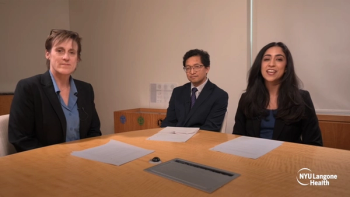
OCT data useful in hands of anterior segment specialties
Anterior segment coherence tomography systems vary in scanning width, depth, and resolution. The data generated are useful for diagnostic and surgical planning purposes. Angiography is being developed as a new application.
Anterior segment optical coherence tomography (AS-OCT) has utility for a number of different applications.
David Huang, MD, PhD, described features of the available systems and reviewed some uses for AS-OCT. Dr. Huang is Peterson Professor of Ophthalmology and professor of Biomedical Engineering, Oregon Health and Science University, Portland, OR.
Specifications
Clinicians can now choose from a number of commercially available AS-OCT systems. The units include devices developed for retinal imaging that have been additionally adapted for corneal imaging and instruments that are dedicated for anterior segment imaging.
The two types of devices differ in wavelength. The combination retinal/corneal imaging devices are all 840 nm wavelength spectral-domain systems and have a benefit of higher axial resolution (3 to 9 μm). In contrast, the dedicated AS-OCT devices are 1,310 nm swept-source systems that give better penetration but at the cost of lower resolution of approximately 10 μm.
“With the 840 nm systems, it is possible to delineate the corneal epithelium and endothelium, Bowman’s layer, and the LASIK flap interface,” Dr. Huang said. “It is more difficult to see these thin structures at the 1,310 nm wavelength, but the reduced scattering loss at the longer wavelength allows more consistent visualization of deeper structures such as the scleral spur, angle recess, and even the ciliary body.”
The dedicated AS-OCT platforms also scan deeper (10-11 mm versus 2-6 mm).
“With their greater depth, the dedicated systems can image the entire anterior segment from the cornea to the lens,” Dr. Huang explained. “Unfortunately, the dedicated AS-OCT systems are only marketed outside the United States at the current time.”
Applications
All of the AS-OCT instruments can be used to precisely map corneal pachymetry and epithelial thickness. The current state of the art for systems commercially available in the United States is to provide a 9 mm scan width with automatic segmentation and diagnostic parameters that are used to screen for keratoconus and distinguish between various types of corneal shape irregularities.
In keratoconus (including forme fruste keratoconus), the epithelial thickness map will show focal thinning at the apex of the cone where the topography map shows anterior steepening, in sharp contrast to the base of the cone where the epithelium is thicker and the topography is flatter.
This inverse relationship between the epithelial thickness and anterior topographic curvature is also found in post-LASIK eyes-the central epithelium is thicker after myopic LASIK and thinner after hyperopic LASIK.
Dr. Huang categorizes the epithelial changes in both keratoconus and post-LASIK corneas as “secondary epithelial modulation.” This contrasts with the other category he terms “primary epithelial deformation” where focal epithelial thickening is the cause of topographic steepening at the same location.
This latter group includes contact lenses-related corneal warpage, epithelial basement membrane dystrophy, and dry eye. In these conditions, the topography shows steepening with epithelial thickening.
AS-OCT can also be used to measure topography, and the corneal power value that is provided can be used for IOL power calculation.
Dr. Huang’s research group, the Center for Ophthalmic Optics and Lasers, have developed an OCT-based IOL formula for post-LASIK cataract surgery that works with Optovue’s AS-OCT systems. It is posted on the lab website (
“The corneal power value that is generated by AS-OCT represents total corneal power from measurement of both the anterior and posterior corneal surfaces. Our research shows that in post-myopic LASIK eyes, the AS-OCT based IOL power calculation performed better than other formulas recommended for post-LASIK eyes, and other investigators have found that it performed as well as other methods such as the Haigis-L formula and intraoperative aberrometry,” Dr. Huang said.
Conclusion
“These findings suggest that the AS-OCT based IOL power calculation may be a good addition to other formulas when performing cataract surgery in these challenging cases.”
Most recently, the capability of AS-OCT has been expanded to non-invasive angiography. Dr. Huang and coworkers have used AS-OCT angiography to image blood vessels in the cornea and the iris.
So far, their research has showed that the depth of neovascularization in the cornea varied depending on the cause of the pathologic vessels. It also identified differences in the features of iris vessels associated with benign and malignant tumors.
David Huang, MD, PhD
E: [email protected]
Dr. Huang owns stocks and receive research grants and patent royalties from Optovue, Inc.
Newsletter
Don’t miss out—get Ophthalmology Times updates on the latest clinical advancements and expert interviews, straight to your inbox.













































